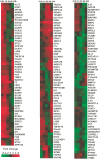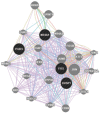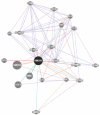Time Course Expression Analysis of 1[2-cyano-3,12-dioxooleana-1,9(11)-dien-28-oyl]imidazole Induction of Cytoprotection in Human Endothelial Cells
- PMID: 28469413
- PMCID: PMC5398299
- DOI: 10.1177/1177625017701106
Time Course Expression Analysis of 1[2-cyano-3,12-dioxooleana-1,9(11)-dien-28-oyl]imidazole Induction of Cytoprotection in Human Endothelial Cells
Abstract
1[2-cyano-3,12-dioxooleana-1,9(11)-dien-28-oyl]imidazole (CDDO-Im), a synthetic derivative of oleanolic acid that exhibits antioxidant and anti-inflammatory activity in several animal and in vitro models, has been shown to be beneficial if given after injury. Although induction of heme oxygenase 1 appears to be a major effector of cytoprotection, the mechanism by which the overall effect is mediated is largely unknown. This study evaluated temporal gene expression profiles to better characterize the early transcriptional events and their relationship to the dynamics of the cytoprotective response in human umbilical vein endothelial cells (HUVEC) to CDDO-Im. Time-course gene expression profiling was performed on HUVEC treated with CDDO-Im for 0.5, 1, 3, 6, and 24 hours. More than 10 000 genes were statistically altered in their expression in at least 1 time point across the time course. Large alterations in immediate-early gene expression were readily detectable within 0.5 hour after administration of CDDO-Im.
Keywords: CDDO-IM; Microarray; cytoprotection; time-course gene expression.
Conflict of interest statement
DECLARATION OF CONFLICTING INTERESTS: The author(s) declared the following potential conflicts of interest with respect to the research, authorship, and/or publication of this article: The opinions or assertions contained herein are the private views of the author and are not to be construed as official or as reflecting the views of the Department of the Army or the Department of Defense.
Figures






Similar articles
-
Cytoprotective Effects of Natural Compounds against Oxidative Stress.Antioxidants (Basel). 2018 Oct 20;7(10):147. doi: 10.3390/antiox7100147. Antioxidants (Basel). 2018. PMID: 30347819 Free PMC article. Review.
-
Cytoprotection of human endothelial cells against oxidative stress by 1-[2-cyano-3,12-dioxooleana-1,9(11)-dien-28-oyl]imidazole (CDDO-Im): application of systems biology to understand the mechanism of action.Eur J Pharmacol. 2014 Jul 5;734:122-31. doi: 10.1016/j.ejphar.2014.03.033. Epub 2014 Apr 3. Eur J Pharmacol. 2014. PMID: 24703885
-
Potent protection against aflatoxin-induced tumorigenesis through induction of Nrf2-regulated pathways by the triterpenoid 1-[2-cyano-3-,12-dioxooleana-1,9(11)-dien-28-oyl]imidazole.Cancer Res. 2006 Feb 15;66(4):2488-94. doi: 10.1158/0008-5472.CAN-05-3823. Cancer Res. 2006. PMID: 16489057
-
The synthetic triterpenoids, CDDO and CDDO-imidazolide, are potent inducers of heme oxygenase-1 and Nrf2/ARE signaling.Cancer Res. 2005 Jun 1;65(11):4789-98. doi: 10.1158/0008-5472.CAN-04-4539. Cancer Res. 2005. PMID: 15930299
-
CDDO and Its Role in Chronic Diseases.Adv Exp Med Biol. 2016;929:291-314. doi: 10.1007/978-3-319-41342-6_13. Adv Exp Med Biol. 2016. PMID: 27771930 Review.
Cited by
-
Caffeic acid phenethyl ester exerts apoptotic and oxidative stress on human multiple myeloma cells.Invest New Drugs. 2019 Oct;37(5):837-848. doi: 10.1007/s10637-018-0701-y. Epub 2018 Nov 22. Invest New Drugs. 2019. PMID: 30465316
-
Cytoprotective Effects of Natural Compounds against Oxidative Stress.Antioxidants (Basel). 2018 Oct 20;7(10):147. doi: 10.3390/antiox7100147. Antioxidants (Basel). 2018. PMID: 30347819 Free PMC article. Review.
-
Deep insights into the response of human cervical carcinoma cells to a new cyano enone-bearing triterpenoid soloxolone methyl: a transcriptome analysis.Oncotarget. 2019 Sep 3;10(51):5267-5297. doi: 10.18632/oncotarget.27085. eCollection 2019 Sep 3. Oncotarget. 2019. PMID: 31523389 Free PMC article.
References
-
- Eskiocak U., Kim S. B., Roig A. I., Kitten E., Batten K., Cornelius C., Zou Y. S., Wright W. E., Shay J. W. (2010) CDDO-Me protects against space radiation-induced transformation of human colon epithelial cells. Radiat Res 174, 27–36. - PubMed
-
- Sussan T. E., Rangasamy T., Blake D. J., Malhotra D., El-Haddad H., Bedja D., Yates M. S., Kombairaju P., Yamamoto M., Liby K. T., Sporn M. B., Gabrielson K. L., Champion H. C., Tuder R. M., Kensler T. W., Biswal S. (2009) Targeting Nrf2 with the triterpenoid CDDO-imidazolide attenuates cigarette smoke-induced emphysema and cardiac dysfunction in mice 106, 250–255. - PMC - PubMed
LinkOut - more resources
Full Text Sources
Other Literature Sources
Molecular Biology Databases

